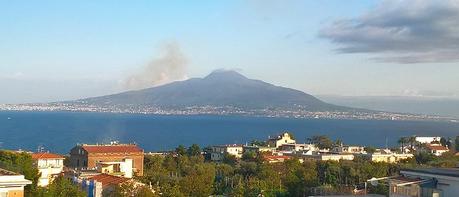 Mount Vesuvius
Mount Vesuvius
Mount Vesuvius is famous for tragically ending the ancient city of Pompeii in 79 A.D. Standing tall near the edge of Italy’s Southern Coast, the massive volcano looms above millions of locals and visitors every day. But is this volcano still dangerous to us?
What is Mount Vesuvius?
It is a stratovolcano which is essentially a fancy term for a type of volcano. In simplest terms, a volcano is an opening in the earth’s crust. The crust of the earth is made by a selection of plates, fitting together like puzzle pieces. However, sometimes these plates move against each other, causing friction which leads to both earthquakes and volcanic eruptions. These plates sometimes move. The friction causes earthquakes and volcanic eruptions near the edges of the plates. The earth’s core contains the magma chamber, which escapes from the volcano’s opening when friction develops between the plates. As well as lava escaping from the top of the Volcano, smoke, ash and pyroclastic flow also flows down. A pyroclastic flow is a blend of solid debris and scorching hot gases. There are three stages of a volcano; active, dormant, or extinct volcanos. Active essentially means that a volcano has eruptive in the last 10,000 years and is due to erupt in the future. Dormant means the last eruption was over 10, 000 years but the volcano still has a change of an outbreak. Extinct is volcanos who will never blow up again, as they are mere mountains now with a terrifying past.
The History of Mount Vesuvius
Mount Vesuvius is ancient, with the oldest dated rock found on the large structure estimating to be about 300,000 years old. There have been a number of eruptions throughout its life, calculated to be in the high 30s. With eight major eruptions in the last 17,000 years, the most recent in 1944 during World War II. Before the tragic eruption of Pompeii, no human knew of Mount Vesuvius’s volcanic power. As locals merely believed it was a large mountain, as they didn’t even have a word for a volcano. The 79 A.D. eruption was the first known documented volcano case in human history, with many believing it was the end of the world when the explosion began.
The Process of Mount Vesuvius’s Eruptions
The beginning of Mount Vesuvius’ eruptions is all due to the movement of the crust’s plates. This usually starts with earthquakes in the region, with the friction of the plates causing the earth to shake before the opening volcano explodes. When the friction is too much, Vesuvius explodes a mountain of smoke, ash, and debris, flowing up to create a large smoke cloud. After this, the pyroclastic wave flows down from the cloud, covering the land with ash, dirt, and red-hot air. Finally, the lava begins to stream down, slowly covering the region with the thick and deadly liquid.
The Eruption of 79 A.D.
For the Pompeii people, earthquakes were nothing new, with little to large tremors affecting the city for years. With the most recent one in 62 A.D. which destroyed a large chunk of the city. Therefore, the first stage and warning earthquakes to Mount Vesuvius’ 79 A.D. was merely brushed off. It wasn’t until Vesuvius let out a loud bang and blasted a huge cloud of volcanic smoke did the citizens become petrified. The smoke cloud stood at 19 kilometres high, causing a large shadow onto the city. After this, the pyroclastic waves speed down the volcano, hitting the city of Pompeii quickly. The waves took to the speed of 700 kilometres per hour and gathered up to 700 degrees Celsius, is no match for the people of Pompeii. This wave was the main cause of death for the citizens, with the wave burning them alive when hit. The entire eruption lasted a full 24 hours, where it slowly buried the city in the thick layer of ash and rock where it would remain until its rediscovery centuries later. It was said over 2,000 people died during this tragic natural disaster, with only a small percentage escaping.
After Pompeii’s Destruction
Since Pompeii’s tragic obliteration, there have been around about 50 different eruptions at Vesuvius. The most recent one was in 1944 during World War II, with the region already suffering dictatorial rule, invasions, and bombings. The United States Army Air Forces 340th Bombardment Group was located at the based of Pompeii when the eruption started. The 1944 disaster lasted an entire week and a half, becoming one of the worst of Vesuvius’ eruptions.
Will it erupt again?
For Vesuvius, it is not a question of if it erupts but when. Scientists have estimated that Italy’s volcano is overdue for an eruption. Due to the large population surrounding the volcano, Mount Vesuvius could jeopardize over 3 million people. There are many ongoing studies, monitoring the volcano’s activity, gas emissions and other indicators will give locals a warning for a future flare-up. The Italian government has also planned an eruption evacuation, to give nearby citizens a quick escape when the time comes. The ‘red zone’ which refers to the areas in closest danger to the volcano, including the city of Naples, have a prearranged evacuation 72 hours ahead of an impending outbreak.
How can you see it?
On your journey to Pompeii, a great stopover is a trek up to the looming volcano that caused the historic city’s demise. Whether you are driving up, a long-time hiker or just stopping through, traveling to the top of Mount Vesuvius is worthwhile. A breathtaking view of the cities Naples and Pompeii, the stunning coastline of the Bay of Naples, as well as the stretching blue sea with the islands Capri and Ischia sitting within. No trip to Pompeii is complete without a visit to this famous Mount Vesuvius.
Recommend Tour: Pompeii & Mount Vesuvius Tour
Price: €69
Tour Company: Sightseeing Tours Italy
Advertisements
